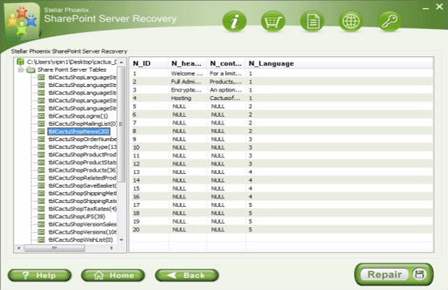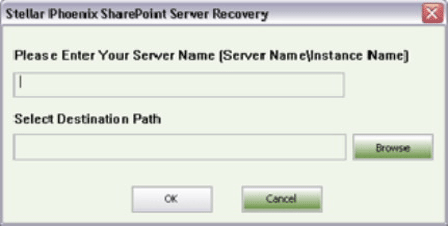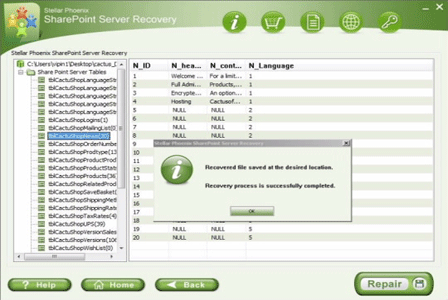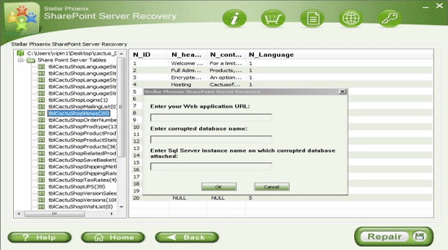SharePoint 2013: Repairing an Installation on a Web Front End! : SharePoint Database Repair Blogs
Published by Jacob Martin on June 10, 2015
There can be a situation when a particular SharePoint 2013 server may have issue. Many of us may think that this may be cause of uninstalling and reinstalling SharePoint 2013 but it is better that you try to repair it. However, running a repair from the Control Panel to programs and features will give an installation error as shown below and it will not let you move forward.
Error 1706. Setup cannot find the required files. Check your connection to the network or CD-ROM drive.
If you are finding the same problem then there is nothing to fear for example here I have a friend named “msiexec” which can be run through any command prompt that includes PowerShell. This simply opens the command prompts and enters the following.
msiexec /f globaloserver.msi
This will let you to perform the repair similar to do it in Control Panel then to the Programs and Features for SharePoint Server 2013. The “/f” here means repairing (fix comes to mind). This other options may make use with /f. This can always run on the msiexec /? If you want to see the other repair options are:
p – For only if file is missing
o – For if the file is missing or older version is installed (default)
e – For if the file is missing or an equal or older version is installed
d – For if the file is missing or a different version is installed
c – For if the file is missing or checksum does not match the calculated value
a – For if it forces all files to be reinstalled
u – For all required user-specific registry entries (default)
m – For all the required computer-specific registry entries (default)
s – For all the existing shortcuts (default)
v – That runs on from source and reaches local package
Thus the /fp would repair and replace files from files only if they were missing. Issuing the ‘/f’ by itself is the same as the ‘/foums’.
For repairing quickly but there are main installs that can attempt you in repairing:
SharePoint Server 2013 (one from above)
msiexec /f globaloserver.msi
SharePoint Shared Components
msiexec /f globalsharedosrv.msi
SharePoint Foundation 2013 Core
msiexec /f globalwsssts.msi
SharePoint Portal
msiexec /f globalspsspswfe.msi
Search Server 2013 Core
msiexec /f globalsearchosrchwfe.msi
If you have some or the other components that is needed to be fixin’, then take a look in the global folder- and the most of the sub-folder names this will give you the clue that what they contain.
But still you are not finding anything out for repairing your errors and problems then it is better to go with the third party SharePoint Repair Tool. It is professional SharePoint Server Recovery software which safely repairs the installation problem of the Web Front End and even the SharePoint databases or SQL Server files and retrieves all the crucial information which is stored on the SharePoint Server. This software can easily extract all data and documents from the damaged SharePoint database.
 |
 |
 |
How to fix SharePoint 2013 Installation error
- Firstly launch the SharePoint Recovery Tool you would find an interface. This interface screen displays two options to recover SharePoint data: ‘Complete Repair’ and ‘Document Recovery’ Select as per your requirement.

- If you choose ‘Complete Repair’, the screen will show the options for selecting and searching SQL Server (.MDF) files. Click on ‘Select File’ to select a SharePoint database for repair. If you do not know the actual path of the database which you want to repair, click on the ‘Search File’ to locate the MDF file in a specific drive. After selecting the desired file initiate the scanning process
- After finishing the scan, the software would generate a tree of all SharePoint database tables and will display it in the left pane. You can select the table in the tree and can have the entire preview in the right pane. Then Click on ‘Repair’ to begin repairing for the selected database.

- After clicking on ‘Repair’, this dialog box will appear. Specify the SQL Server name or Instance name and the desired destination path. Click on the ‘Browse’ option to choose the destination path. And select ‘OK’ button.

- Once this process gets completed, you would find a dialog box that displays this message ‘Recovered file saved at the desired location. This shows that Recovery Process has successfully completed’. And select ‘OK’ button.

- You would find another dialog box that asks whether you want to attach the repaired database to the web application. If you click on ‘Yes’ button, the above dialog box will be displayed. In the web application URL type, the name of the corrupt database and SQL Server Instance name. Then Select ‘OK’ button and proceed. When the process gets finished, you would be able to access the repaired database by opening the web application.

24 Total Views 1 Views Today
